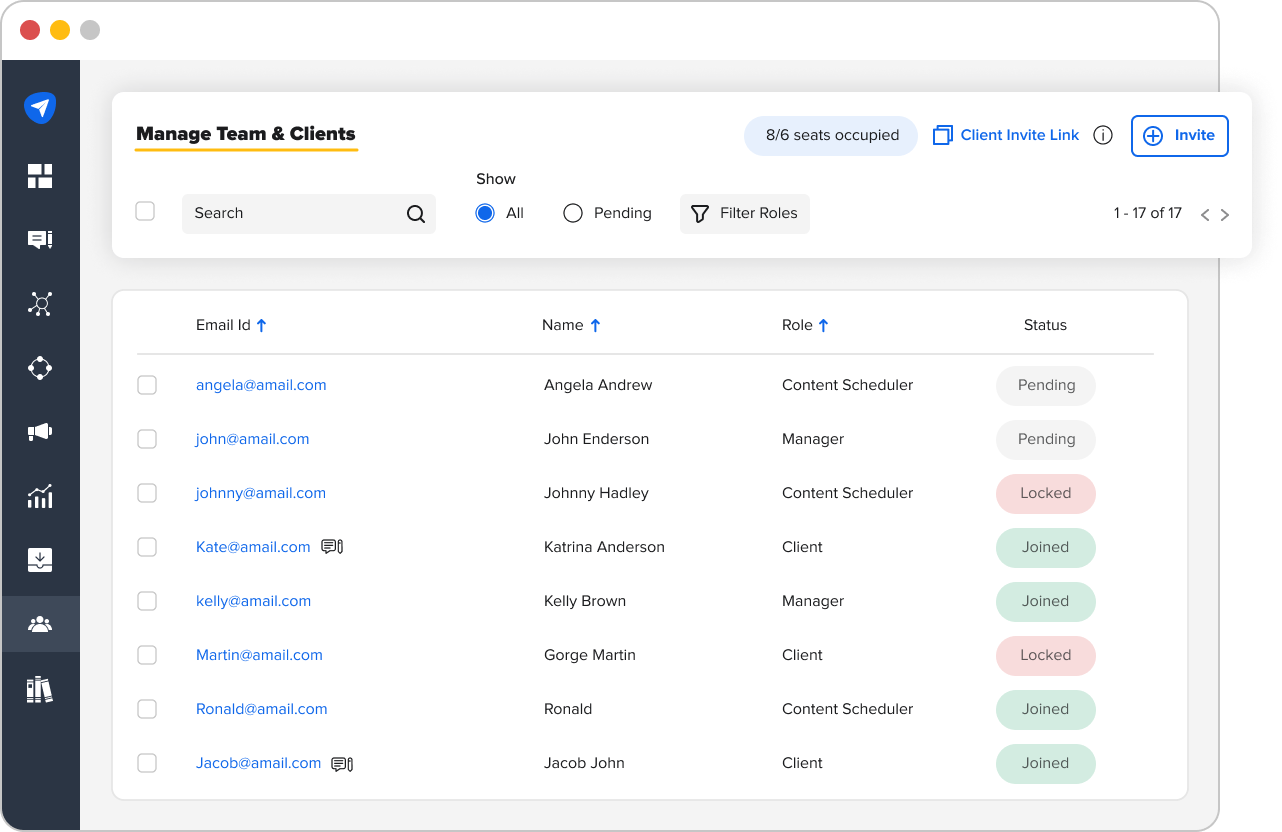When it comes to project management, setting and sticking to hard deadlines is essential.
Deadlines allow you to deliver results reliably, track your project’s progress, and structure its timeline.
However, setting and meeting deadlines comes with numerous challenges. Be too generous with your deadlines and you will work well below maximum efficiency. Be too demanding, and you and your team will end up working overtime in a frenzy of adrenaline with a hard deadline looming.
Navigating deadlines remains challenging, with only 64% of projects completed on time, emphasizing the importance of efficient processes and time management.
To avoid either scenario, here are our top 10 tips for managing your project timelines and ensuring you always meet hard deadlines.
10 Tips to Ensure You Are Meeting Hard Deadlines
1. Outline Your Projects, Goals, and Their Deadlines
To begin with, you need to outline all your projects and define their goals. Imagine you’re managing a digital marketing agency with various tasks like content creation, SEO optimization, and social media campaigns running simultaneously. Keeping track of objectives and hard deadlines can be tricky in such a dynamic environment.
Take the time to outline which projects you need to stay on top of and what you ultimately hope to achieve with each one. For example, your content creation project might increase organic website traffic, while your social media campaign aims to boost brand awareness and engagement.
By clearly defining these goals, you can better sort out your priorities and structure the timeline of each project you need to manage. This approach ensures you maintain a clear focus and direction, enhancing your agency’s efficiency and effectiveness.
2. Use a Project Management Tool to Keep Track
Next up, consider using a project management tool.
Some people are happy with old-fashioned Filofax paper planners. But in the modern business world, more sophisticated solutions are available. A project management tool helps you visualize your progress, manage tasks, and stay on top of deadlines.
In fact, a 2021 report by Wellingtone, a project management consultancy, claims that 89% of organizations have at least one project management tool. This further cements the importance of a good project management tool.
Plus, it facilitates collaboration. Adding multiple users to the same project allows you to assign roles and tasks and keep track of their work.
As a digital marketing agency, having SocialPilot in your arsenal for your social media management would be highly beneficial. This effective and agile tool can help you manage multiple accounts and team members.
For instance, you can assign roles to each of your team members, from someone responsible purely for scheduling content to someone who has to review drafts for posts by a certain deadline.

Case Study
Look at this interesting UNICEF case study by the project management tool Trello. It demonstrates how project management tools like theirs can help organizations streamline their workflow, improve communication and collaboration, and increase overall efficiency.

Using Trello’s visual boards, checklists, and progress-tracking features, UNICEF could keep all team members on the same page and easily track progress across multiple projects simultaneously. This approach helps eliminate communication barriers and ensures that each team member clearly understands their responsibilities and deadlines.
3. Break Projects Up Into Smaller Milestones
As a next step in project timeline management, you need to break your overall goals into smaller milestones.
Having a goal such as “Write the organization’s annual report” in your calendar will not help you draw up a realistic timeline to finish it. Instead, split this large task up into smaller ones, such as:
- Collect information from individual departments, including time for follow-ups
- Structure documents and write drafts of individual chapters
- Forward the first draft to managers for review
- Make edits
- Forward the second draft to the copy editor for proofreading
- Forward finished draft to graphic design and provide access to photos of flagship projects
Dividing a larger project into smaller, more manageable tasks ensures that each step is completed on time and keeps the team on track to meet the project’s deadline.
This approach also allows for more efficient resource allocation and provides opportunities to adjust or pivot the project as needed.
4. Clarify Timelines and Dependencies Between Results
Once you’ve broken your project into smaller units, clarifying the timelines and identifying dependencies between them is important. This allows you to optimize your efficiency and ensure that tasks are completed in the correct order.
For example, if you’re developing an online app for your company, certain pre-conditions, such as a website update, may need to be fulfilled before you can proceed with integrations. Once these pre-conditions have been met, you can work on several integrations simultaneously, such as Azure, Airtable, and Zendesk.
By clearly defining these dependencies, you can avoid delays and ensure that each team member knows exactly what needs to be completed before moving on to the next task. This approach also allows for better resource allocation and can help ensure that the project is completed on time and within budget.
By staying organized and aware of dependencies between project milestones, you can effectively manage project timelines and meet hard deadlines.
5. Set Priorities Among Tasks and Hard Deadlines You Set
Another important step in setting hard deadlines you’ll meet is to set priorities for the tasks you and your team have to complete.
With limited time and resources, it’s essential to identify the most critical tasks and prioritize them accordingly. For instance, if you’re managing a website redesign project, you’ll need to prioritize tasks like creating a new site structure and developing content before moving on to less critical tasks like designing custom icons.
Identify your most immediate goals and rank the milestones on which future tasks depend more highly. This ensures that the project moves forward in the right direction and allocates resources effectively. Most importantly, this helps the team focus on the most important tasks at any given time.
Case Study
L’Oreal, the global beauty brand, faced a challenging deadline with creating a new digital platform for its salon customers. To meet the deadline, the team had to set priorities among tasks and hard deadlines they set.
By breaking the project down into smaller, more manageable tasks and focusing on high-priority goals, the team was able to stay organized and on track.

Asana, a project management tool, helped them keep track of progress and allocate resources effectively, ensuring the project was completed on time and within budget. L’Oreal’s successful project completion enabled them to improve its customer experience and stay competitive.
Read more: 10 Agency Project Management Tools for 2023
6. Factor in Unforeseen Circumstances and Delays
No matter how well you plan your project and set hard deadlines, unforeseen circumstances and delays are inevitable. Accidents, family emergencies, new client requests, and even a pandemic can all impact project timelines.
To manage these unforeseen delays, it’s important to factor in additional buffer time and accommodate a certain number of unforeseen circumstances.
Hofstadter’s Law, which states that everything always takes longer than expected, reminds us to be realistic when planning project timelines. By factoring in potential delays, you can better manage unforeseen circumstances and keep the project on track to meet hard deadlines.
7. Check In With Project Partners and Collaborators
To ensure effective collaboration and meet hard deadlines, checking in with project partners and collaborators regularly is essential. Doing so lets you identify potential conflicts, issues, or delays early and take corrective action before they impact project timelines.
The best way to make sure that everyone is on the same page is to check in during a team meeting, either in person or virtually and outline goals, availabilities, and a general project timeline.
When checking in with your partners and collaborators, ensure everyone agrees that your hard deadlines are realistic and achievable. This way keeping people accountable later is much easier, and you’ll avoid conflicts between multiple projects. Moreover, it’s essential to maintain open communication channels and keep everyone informed and updated regularly to avoid any potential misunderstandings or issues.
8. Keep Hard Deadlines Optimistic But Achievable
Setting hard deadlines that are both optimistic and achievable is essential for managing project timelines effectively. While an unrealistic deadline can create undue stress and anxiety, setting too generous deadlines can lead to wasted time and resources.
To strike the right balance, it’s important to be optimistic but realistic when setting deadlines. A hard deadline can be an excellent motivator and driver of productivity, but it’s important not to be overly ambitious and set deadlines too tightly. By setting achievable but still ambitious deadlines, you can motivate your team while avoiding unnecessary stress and anxiety.
Remember, the key is to find the sweet spot between optimistic and achievable deadlines. This way, you can ensure that your team remains focused, motivated, and productive, ultimately leading to the successful completion of the project.
Case Study
Atlassian’s ShipIt hackathon is a prime example of how keeping hard deadlines optimistic but achievable can foster innovation and improve productivity.

Watch the video here.
By setting a 24-hour deadline for the project, the team was able to focus their efforts and generate innovative solutions without the pressure of perfection. This approach created a culture of innovation, ultimately leading to successful outcomes for Atlassian’s products.
By balancing optimism with realism when setting deadlines, organizations can motivate their teams while avoiding unnecessary stress and anxiety, ultimately leading to project success.
9. Take Ownership of Progress and Celebrate Success
Holding yourself accountable when working on a project is crucial to meeting your hard deadlines. If you work on a team, others will rely on you to complete your tasks on time. But if you’re working alone, motivating yourself to stay on track is important.
One way to do this is by setting up a system of rewards for completing tasks on time, for example, treating yourself to a movie or dinner after completing a major milestone. Celebrating your successes not only helps boost morale but also serves as a reminder of why you’re working so hard towards your hard deadlines in the first place.
10. Avoid Scope Creep
Finally, avoiding scope creep is one of the most important things regarding project timelines.
Social creep refers to any on-the-fly changes or uncontrolled growth in a project’s scope, typically caused by the client or stakeholder requests, internal changes, or unforeseen circumstances. These changes can cause delays, budget overruns, and missed deadlines, making it challenging to manage the project timeline effectively.
Establish clear project boundaries and ensure that all stakeholders understand the scope and objectives of the project from the outset to avoid social creep.
Additionally, maintaining open communication channels with stakeholders and regularly checking in can help identify potential issues or changes early on, allowing you to take corrective action before they impact project timelines.
Case Study
The Healthcare.gov website launch in 2013 is a prime example of how scope creep and uncontrolled growth can derail a project. The project suffered from poor planning, unclear objectives, and a lack of communication between stakeholders, leading to delays and technical issues.

By avoiding “social creep” and carefully managing the project scope, these pitfalls could have been avoided, and there would have been a more successful project outcome. You can read more about this here.
Conclusion
Deadlines are fundamental to project management and timelines. Hard deadlines can be intimidating, but they provide structure to a project and motivation for all the participants.
When it comes to setting deadlines and mapping out a project’s timeline, the points mentioned above are something you must keep in mind.
Ultimately, structuring a project timeline and setting deadlines becomes easier with practice. While initially overwhelming, you’ll eventually fall into a routine and know exactly which pitfalls to look for.


